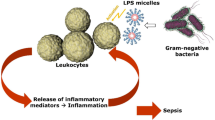Abstract
Horseshoe crabs fight off infectious agents with a complex array of proteins present in amebocytes, the major cell type in their hemolymph. These amebocytes contain both large and small granules (1). When exposed to bacteria or other infectious agents the amebocytes release proteins into their surroundings by exocytosis. The small granules of Limulus amebocytes contain antibacterial proteins, including polyphemusins and the big defensins (2). The large granules contain the Limulus anti-lipopolysaccharide factor (LALF) and the clot-forming group of serine protease zymogens. Exocytosis is initiated by the reaction of amebocytes with lipopolysaccharide (LPS) from Gram-negative bacteria or other microbial components. LPS is also called endotoxin because it is found in the outer membrane of the gram-negative bacterial cell wall. A solid clot forms in response to the lipid A portion of LPS, thereby walling off the infection site or preventing the loss of blood when the animal is damaged physically (3).
Access this chapter
Tax calculation will be finalised at checkout
Purchases are for personal use only
Similar content being viewed by others
References
Toh, Y., Mizutani, A., Tokunaga, F., Muta, T., and Iwanaga, S. (1991) Morphology of the granular hemocytes of the Japanese horseshoe crab Tachypleus tridentatus and immunocytochemical localization of clotting factors and antimicrobial substances. Cell Tissue Res. 266, 137–147.
Iwanaga, S., Kawabata, S., and Muta, T. (1998) New types of clotting factors and defense molecules found in horseshoe crab hemolymph: their structures and functions. J. Biochem. 123, 1–15.
Levin, J. and Bang, F. B. (1964) The role of endotoxin in the extracellular coagulation of Limulus blood. Bull. Johns Hopkins Hosp. 115, 265–274.
Iwanaga, S., Miyata, T., Tokunaga, F., and Muta, T. (1992) Molecular mechanism of hemolymph clotting system in Limulus. Thrombos. Res. 68, 1–32.
Levin, J., Tomasulo, P. A., and Oser, R. S. (1970) Detection of endotoxin in human blood and demonstration of an inhibitor. J. Lab. Clin. Med. 75, 903–911.
Morita, T., Tanaka, S., Nakamura, T., and Iwanaga, S. (1981) A new (1→3)-β-d-glucan-mediated coagulation pathway found in Limulus amebocytes. FEBS Lett. 129, 318–321.
Roslansky, P. F. and Novitsky, T. J. (1991) Sensitivity of Limulus amebocyte lysate (LAL) to LAL-reactive glucans. J. Clin. Microbiol. 29, 2477–2483.
Fink, P. C., Lehr, L., Urbaschek, R. M., and Kozak, J. (1981) Limulus amebocyte lysate test for endotoxemia: investigations with a femtogram sensitive spectrophometric assay. Klin. Wochenschr. 59, 213–218.
Remillard, J., Gould, M. C., Roslansky, P. F., and Novitsky, T. J. (1987) Quantitation of endotoxin in products using the LAL kinetic turbidimetric assay, in Detection of Bacterial Endotoxins with the Limulus amebocyte lysate test (Watson, S., Levin, J., and Novitsky, T. J., eds.), Alan R. Liss, New York, pp. 197–210.
Iwanaga, S., Morita, T., Harada, T., Nakamura, S., Niwa, M., Takada, K., Kimura, T., and Skakibara, S. (1978) Chromogenic substrates for horseshoe crab clotting enzyme: its application for the assay of bacterial endotoxins. Haemostasis 7, 183–188.
Novitsky, T. J. (1994) Limulus amebocyte lysate (LAL) detection of endotoxin in human blood. J. Endotoxin Res. 1, 253–263.
Warren, H. S., Novitsky, T. J., Ketchum, P. A., Roslansky, P. F., Kania, S., and Siber, G. R. (1985) Neutralization of bacterial lipopolysaccharide by human plasma. J. Clin. Microbiol. 22, 590–595.
Greisman, S. E., Young, E. J., and Dubuy, B. (1978) Mechanism of endotoxin tolerance. VII. Specificity of serum transfer. J. Immunol. 111, 1349–1360.
Cooperstock, M. S., Tucker, R. P., and Baublis, J. V. (1975) Possible pathogenic role of endotoxin in Reye’s syndrome. Lancet 1, 1272–1274.
Roth, R. I., Levin, F. C., and Levin, J. (1990) Optimization of detection of bacterial endotoxin in plasma with the Limulus test. J. Lab. Clin. Med. 116, 153–161.
Tamura, H., Tanaka, S., Obayashi, T., Yoshida, M., and Kawai, T. (1991) A new sensitive method for determining endotoxin in whole blood. Clin. Chim. Acta 200, 35–42.
Tamura, H., Tanaka, S., Obayashi, T., Yoshida, M., and Kawai, T. (1992) A new sensitive microplate assay of plasma endotoxin. J. Clin. Lab Anal. 6, 232–238.
Ketchum, P. A., Parsonnet, J., Stotts, L. S., Novitsky, T. J., Schlain, B., Bates, D. W., and Investigators of the AMCC SEPSIS Project. (1997) Utilization of a chromogenic Limulus amebocyte lysate blood assay in a multi-center study of sepsis. J. Endotoxin Res. 4, 9–16.
Obayashi, T., Yoshida, M., Mori, T., Goto, H., Yasuoka, A., Iwasaki, H., Teshima, H., Kohno, S., Horiuchi, A., Ito, A., Yamaguchi, H., Shimada, K., and Kawai, T. (1995) Plasma (1→3)-β-d-glucan measurement in diagnosis of invasive deep mycosis and fungal febrile episodes. Lancet 345, 17–20.
Author information
Authors and Affiliations
Editor information
Editors and Affiliations
Rights and permissions
Copyright information
© 2000 Humana Press Inc.
About this protocol
Cite this protocol
Ketchum, P.A., Novitsky, T.J. (2000). Assay of Endotoxin by Limulus Amebocyte Lysate. In: Evans, T.J. (eds) Septic Shock Methods and Protocols. Methods in Molecular Medicine™, vol 36. Humana Press. https://doi.org/10.1385/1-59259-216-3:3
Download citation
DOI: https://doi.org/10.1385/1-59259-216-3:3
Publisher Name: Humana Press
Print ISBN: 978-0-89603-730-4
Online ISBN: 978-1-59259-216-6
eBook Packages: Springer Protocols




